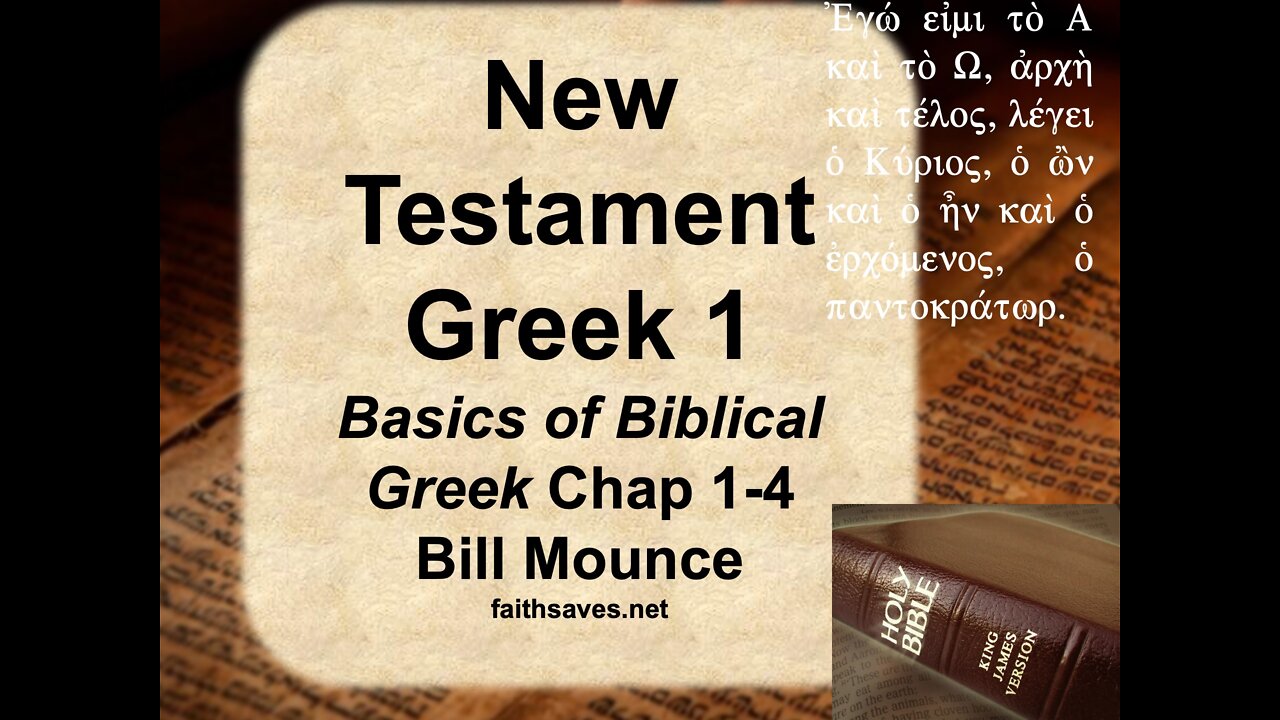Premium Only Content

New Testament / Koine Greek, 1st year, Lect #1: Intro & Basics of Biblical Greek, Mounce, Chap. 1-4
Lecture #1 in New Testament or Koine Greek; first year Greek at a college or seminary level taught by independent Baptist professor Thomas Ross, utilizing WIlliam (Bill) Mounce, Basics of Biblical Greek, and other texts.
Learn more about the class at:
https://faithsaves.net/Greek-courses/
Textbooks include William Mounce, Basics of Biblical Greek Grammar; Bill Mounce, Basics of Biblical Greek Workbook; the Greek Textus Receptus or Received Text; T. Michael Halcomb, Speak Koine Greek: A Conversational Phrasebook & 800 Words and Images: a New Testament Greek Vocabulary Builder. Recommended texts include Frederick W. Danker, A Greek-English Lexicon of the New Testament and other Early Christian Literature, 3rd. ed. (BDAG) & William D. Mounce, The Morphology of Biblical Greek.
The New Testament is approached from a Bible-believing perspective as the perfectly inspired and preserved Word of God.
Lecture #1 covers Basics of Biblical Greek chapters 1-4, including the Greek alphabet with its consonants, vowels, diphthongs, pronunciation, and syllabification, as well as the vocabulary for those chapters. The first chapter covers a basic overview of the history of the Greek language explains the transition from classical to Koine or common Greek. What college and seminary students need to memorize, and the importance of time, consistency, and discipline, comes under discussion in chapter two. Chapter three covers how to write and pronounce the alphabet, with its consonants, vowels, and diphthongs, and the rough and smooth breath marks that appear on words beginning with a vowel. The letters of the Greek alphabet are:
Alpha ἄλφα a Α α
Beta βῆτα b Β β
Gamma γάμμα g Γ γ
Delta δέλτα d Δ δ
Epsilon ἒψιλόν e Ε ε
Zeta ζῆτα z Ζ ζ
Eta ἦτα ē Η η
Theta θῆτα th Θ θ
Iota ἰῶτα i Ι ι
Kappa κάππα k Κ κ
Lambda λάμβδα l Λ λ
Mu μῦ m Μ μ
Nu νῦ n Ν ν
Xi ξῖ x Ξ ξ
Omicron ὂ μικρόν o Ο ο
Pi πῖ p Π π
Rho ῥῶ r Ρ ρ
Sigma σίγμα s Σ σ/ς
Tau ταῦ t Τ τ
Upsilon ὖ ψιλόν u/y Υ υ
Phi φῖ ph Φ φ
Chi χῖ ch Χ χ
Psi ψῖ ps Ψ ψ
Omega ὦ μέγα ō Ω ω
The Greek vowels are α, ε, η, ι, ο, υ, and ω. The rough breath mark is a ῥ placed over the first vowel. Words that begin with rho and upsilon always have a rough breath mark. The smooth breath mark appears like a ἀ over an initial vowel and is not pronounced.The Greek diphthongs are αι, ει, οι, αυ, ου, υι, ευ & ηυ. Iota subscript is a small iota written under three vowels: ᾳ, ῃ, ῳ.
Chapter four covers rules for Greek syllabification-the division of syllables, as well as punctuation and accent marks. The Greek , means a comma in Greek. The . is a period. The · means a semicolon, and the Greek ; is a question mark. Greek apostrophe and elision is covered. The Greek acute accent specifies a rise in pitch that the pitchon the accented syllable (BBG example: αἰτέω).
The Greek grave accent specifies a drop in pitch on the accented syllable (BBG example: καὶ). The circumflex accent specifies that one's voice rises and then drops slightly on the accented syllable (BBG example: ἁγνῶς). Accents assist with pronunciation, memorization, and the identification of certain words. The acute ( ´) can occur on any of the last three syllables. The circumflex (ῶ) can occur only on one of the last two syllables and will always be over a long vowel.The grave (ὶ) is formed when a word is normally accented with an acute on the final syllable. When not followed by a punctuation mark, a word's acute accent becomes a grave. Accents on nouns try to stay on the same syllable-consistent accent. Accents on verbs move as close to the beginning of the verb as possible-recessive accent.
Greek syllabification is very similar to English syllabification. The basic rules are:
1.) There is one vowel (or diphthong) per syllable.
2.) A single consonant by itself goes with the following vowel.
3.) Two consecutive vowels that do not form a diphthong are divided.
4.) A consonant cluster that can not be pronounced together is divided, and the first consonant goes with the preceding vowel.
5.) A consonant cluster that can be pronounced together goes with the following vowel.
6.) Double consonants are divided.
7.) Compound words are divided where joined.
William Mounce's Basics of Biblical Greek assigns fewer vocabulary words than many other grammars, because the 319 words assigned cover approximately 80% of the word usage in the New Testament. Dr. Ross supplements the vocabulary in Bill Mounce's grammar with words from Halcomb. Students will learn not only to understand, exegete, and translate the New Testament but also to converse in Greek.
The FaithSaves website's section on college courses contains course syllabi, handouts, and other important material for taking this course.
-
 1:04:13
1:04:13
Crypto Power Hour
14 hours ago $7.03 earnedIn The Blockchain World,, What Is TOKEN MINTING
41.5K9 -
 2:04:28
2:04:28
BEK TV
2 hours agoTrent Loos in the Morning - 11/12/2025
17.9K -
 17:23
17:23
T-SPLY
13 hours agoThousands Of ICE Watch Kits Passed Out In Chicago!
25.2K23 -
 25:09
25:09
Jasmin Laine
19 hours agoReporter CATCHES Carney Red-Handed—Liberal MP SNAPS in Public MELTDOWN
20.8K36 -
 9:05
9:05
Adam Does Movies
17 hours ago $1.90 earnedIT: Welcome To Derry Episode 3 - Recap
18.3K1 -
 14:43
14:43
Producer Michael
19 hours agoBILLION DOLLAR GOLD MOGUL'S PRIVATE WATCH COLLECTION
15K -
 38:44
38:44
State of the Second Podcast
19 hours agoThe Mini Gun Brand Everyone’s Talking About (ft. Goat Guns)
14.3K3 -
 9:59
9:59
TheSaltyCracker
17 hours agoBerkeley Communists Rob & Attack Man Outside TPUSA Event
98.7K187 -
 36:09
36:09
ZeeeMedia
16 hours agoFauci-Era Animal Experiments Continue, Texas New Push for Digital ID | Daily Pulse Ep 141
26.6K19 -
 2:10:12
2:10:12
Side Scrollers Podcast
22 hours agoMAJOR Hasan Allegations + Arc Raiders Review CONTROVERSY + Craig TRENDS on X + More | Side Scrollers
143K24